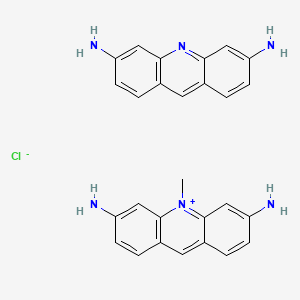



1. 2,8-diamino-10-methylacridinium Chloride Mixture With 2,8-diaminoacridine
2. Xanthacridinum
1. 8048-52-0
2. Acriflavin
3. Acriflavine Neutral
4. Flavacridine
5. Triphaflavine
6. 65589-70-0
7. Acridine-3,6-diamine;10-methylacridin-10-ium-3,6-diamine;chloride
8. Dsstox_cid_25848
9. Dsstox_rid_81170
10. Dsstox_gsid_45848
11. Acriflavine [nf]
12. Flavacridinum
13. 3,6-diamino-10-methylacridinium Chloride-3,6-acridinediamine Mixt
14. Fungus Cure
15. Cas-69235-50-3
16. Mfcd00064307
17. Neutroflavin
18. Ccris 5428
19. Unii-1t3a50395t
20. Acriflavini Chloridium
21. Flavacridine Hydrochloirde
22. Acriflavine, Hydrochloride
23. Acriflavine Dihydrochloride
24. Schembl77745
25. Acriflavinium Chloride [inn]
26. Unii-1s73vw819c
27. Acriflavine Hydrochloride [nf]
28. Chembl2360628
29. Dtxsid30988185
30. 1s73vw819c
31. Amy22363
32. Rkl10102
33. Tox21_111337
34. 3,6-diamino-10-methylacridin-10-ium Acridine-3,6-diamine Chloride
35. Akos015902524
36. Tox21_111337_1
37. 1t3a50395t
38. Cs-6959
39. Nsc 757387
40. Ncgc00178831-03
41. Hy-100575
42. A0134
43. D88218
44. 3,6-diamino-10-methylacridiniumchloride-3,6-acridinediaminemixt
45. 3,6-diamino-10-methylacridinium Chloride Mixt. With 3,6-diaminoacridine
46. 3,6-diamino-10-methylacridin-10-ium Chloride--acridine-3,6-diamine (1/1/1)
47. Acriflavine (mixture Of 3,6-diamino-10-methylacridinium Chloride And 3,6-diaminoacridine)
48. 68518-47-8
| Molecular Weight | 469.0 g/mol |
|---|---|
| Molecular Formula | C27H25ClN6 |
| Hydrogen Bond Donor Count | 4 |
| Hydrogen Bond Acceptor Count | 6 |
| Rotatable Bond Count | 0 |
| Exact Mass | 468.1829225 g/mol |
| Monoisotopic Mass | 468.1829225 g/mol |
| Topological Polar Surface Area | 121 Ų |
| Heavy Atom Count | 34 |
| Formal Charge | 0 |
| Complexity | 486 |
| Isotope Atom Count | 0 |
| Defined Atom Stereocenter Count | 0 |
| Undefined Atom Stereocenter Count | 0 |
| Defined Bond Stereocenter Count | 0 |
| Undefined Bond Stereocenter Count | 0 |
| Covalently Bonded Unit Count | 3 |
Intercalating Agents
Agents that are capable of inserting themselves between the successive bases in DNA, thus kinking, uncoiling or otherwise deforming it and therefore preventing its proper functioning. They are used in the study of DNA. (See all compounds classified as Intercalating Agents.)
Anti-Infective Agents, Local
Substances used on humans and other animals that destroy harmful microorganisms or inhibit their activity. They are distinguished from DISINFECTANTS, which are used on inanimate objects. (See all compounds classified as Anti-Infective Agents, Local.)
Fluorescent Dyes
Chemicals that emit light after excitation by light. The wave length of the emitted light is usually longer than that of the incident light. Fluorochromes are substances that cause fluorescence in other substances, i.e., dyes used to mark or label other compounds with fluorescent tags. (See all compounds classified as Fluorescent Dyes.)
